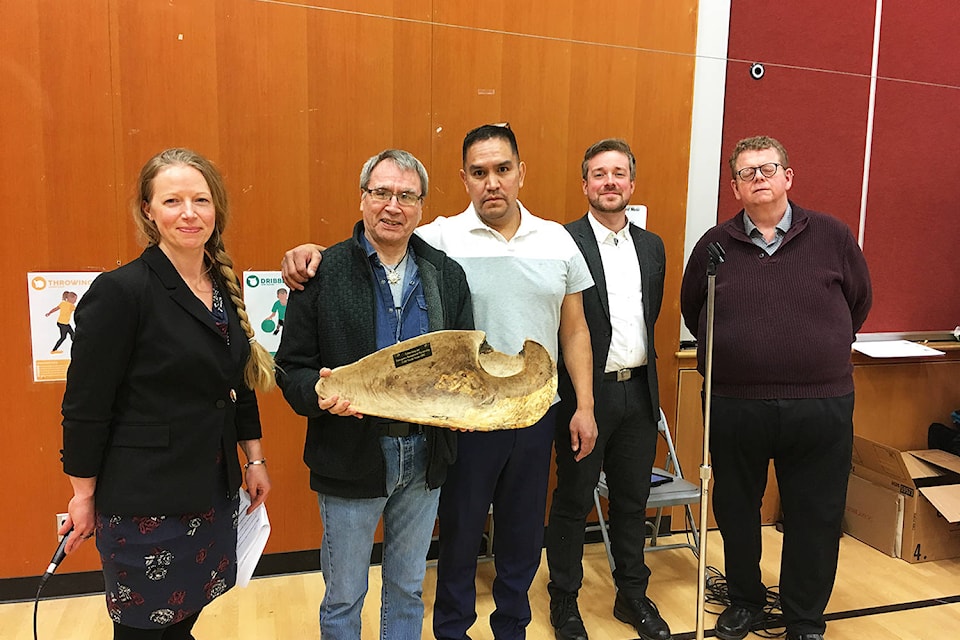The Nuxalk Nation and the CCRD have signed a historic memorandum of understanding with the British Columbia government to better co-ordinate efforts to prepare for, mitigate, respond to and recover from emergencies in the Bella Coola Valley.
The signing took place at the Acwsaltca School on Saturday, March 2, and was officially recognized with the traditional sharing of a meal and cultural dance performances by the students of Acwsalcta School.
The MOU had its beginnings during the wildfires of 2017, when the CCRD and the Nuxalk Nation began an informal yet effective partnership to tackle the challenges facing the Bella Coola Valley that summer. Closed roads, stranded residents and tourists, cancelled community events and major disruption to the tourism sector all had a significant effect on the local economy.
Legislation, both federal and provincial, does not lend itself well to communities such as the Bella Coola Valley. Provincial legislation dictates that local emergencies are the responsibility of the regional district, while federal legislation places that responsibility on-reserve for First Nations. In small, remote communities such as the Valley, this framework can make dealing with local emergencies even more challenging and result in duplication of services, inefficiencies, and systematic exclusion.
After the 2017 wildfires, representatives of the CCRD and the Nuxalk Nation began to advocate provincial officials to raise awareness of the challenges the region faced during times of emergency response.
This advocacy work was performed by former CCRD Chair Alison Sayers and members of the board, Nuxalk Chief Wally Webber and council members, CCRD CAO Courtney Kirk, and Nuxalk Nation Administrator Wilma Mack. All parties advocated tirelessly with provincial elected officials and staff at Ministry of Public Safety, Ministry of Indigenous Relations and Reconciliation, and Emergency Management BC. The group asked for more financial, human, and training resources from the province, as well as formal recognition of the partnership that had been started.
The MOU was created to lead and co-ordinate emergency management planning by addressing any emergency preparedness, response, recovery or mitigation gaps that have impacts beyond a single jurisdiction, providing oversight on high-level emergency management issues, and acting as a vehicle to bring other relevant stakeholders, provincial ministries, federal departments and Indigenous communities together to collaborate on emergency management initiatives.
“This partnership will be the vehicle we need to bring all partners to the table to discuss emergency management in the region,” said Jennifer Rice, Parliamentary Secretary for Emergency Preparedness. “When it comes to emergency preparation, mitigation, response and recovery, more remote areas have unique challenges. By sitting down and working together, we can help make the Bella Coola valley safer by creating emergency plans that help meet specific needs.”
It is the first of its kind in the province, and may serve as a basis for similar intergovernmental partnerships throughout BC.
A big part of the implementation of the MOU will be a shared emergency coordinator reporting to both the CCRD and Nuxalk Nation Administration. The shared coordinator will be the primary administrative lead supporting the Emergency Council toward regular meetings, trainings, and planning, and sharing of expertise, information, and resources.
Samuel Schooner, CCRD chair, is optimistic that the new partnership will lead to more disaster-resilient communities.
“We know that the Nuxalk Nation have survived and thrived in their Ancestral Territories for thousands of years,” Schooner said. “Having Nuxalkmc’s voice central in our emergency management structure just makes sense and is long overdue in our program. This regional partnership will serve as a model for other areas for the Province to establish similar partnerships. The model is flexible to include other First Nations communities, other levels of government and regional stakeholders.”
The MOU was made official with the signatures of MLA Jennifer Rice, CCRD Chair Samuel Schooner, and Nuxalk Nation Chief Wally Webber.
There was also a ceremonial “extending of the olive branch” from the CCRD to the Nuxalk Nation, whereby Chief Webber was presented with a carved olive tree bowl meant to signify new beginnings and the establishment of a new relationship between the CCRD and the Nuxalk Nation.
“It has become crystal clear that the effects of climate change must be taken seriously,” said Webber. “The Nuxalk Nation has formally decided to enter this partnership because every life matters. We look forward to proactively moving forward in preparing for any potential emergencies in collaboration with Emergency Management BC and the CCRD.”
